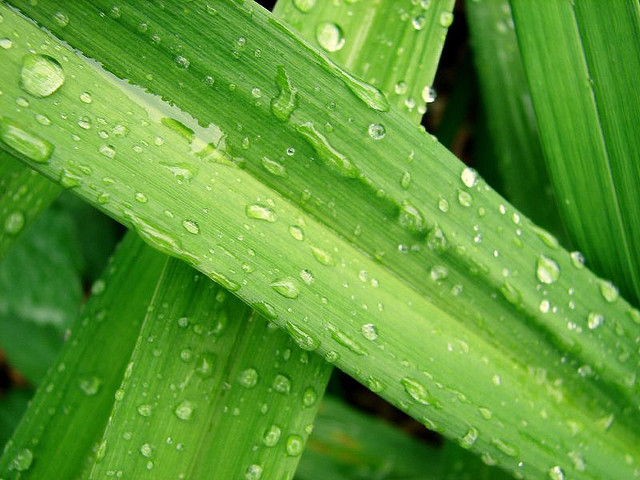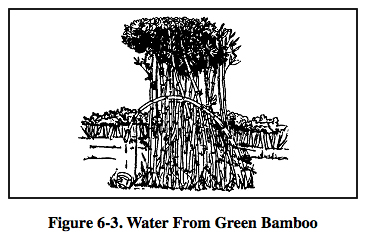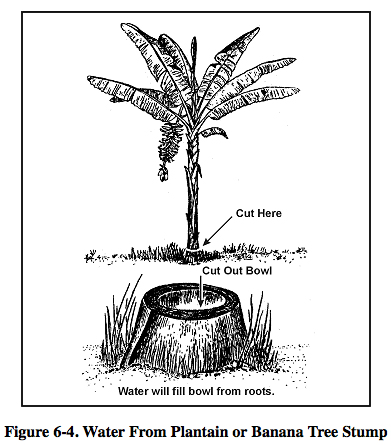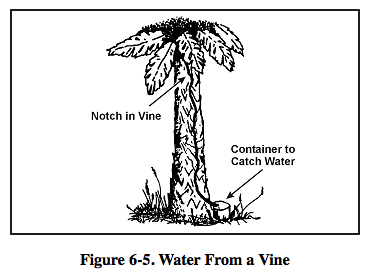
A source of vegetation can often double as a source of water. There are many methods to procure water in the wild, such as distilling, purifying and trapping moisture. There is also the method of cutting into plants that store water.
Green bamboo thickets are an excellent source of fresh water. Water from green bamboo is clear and odorless. To get the water, bend a green bamboo stalk, tie it down, and cut off the top (Figure 6-3). The water will drip freely during the night. Old, cracked bamboo may also contain water.
CAUTION: Purify the water before drinking it.
Wherever you find banana trees, plantain trees, or sugarcane, you can get water. Cut down the tree, leaving about a 30-centimeter (12-inch) stump, and scoop out the center of the stump so that the hollow is bowl-shaped. Water from the roots will immediately start to fill the hollow. The first three fillings of water will be bitter, but succeeding fillings will be palatable. The stump (Figure 6-4) will supply water for up to 4 days. Be sure to cover it to keep out insects.
Some tropical vines can give you water. Cut a notch in the vine as high as you can reach, then cut the vine off close to the ground. Catch the dropping liquid in a container or in your mouth (Figure 6-5).
CAUTION: Ensure the vine is not poisonous.
The milk from young, green (unripe) coconuts is a good thirst quencher. However, the milk from mature, brown, coconuts contains an oil that acts as a laxative. Drink in moderation only.
CAUTION: Do not drink the liquid if it is sticky, milky, or bitter tasting.
In the American tropics you may find large trees whose branches support air plants. These air plants may hold a considerable amount of rainwater in their overlapping, thickly growing leaves. Strain the water through a cloth to remove insects and debris.
You can get water from plants with moist pulpy centers. Cut off a section of the plant and squeeze or smash the pulp so that the moisture runs out. Catch the liquid in a container.
Plant roots may provide water. Dig or pry the roots out of the ground, cut them into short pieces, and smash the pulp so that the moisture runs out. Catch the liquid in a container.
Fleshy leaves, stems, or stalks, such as bamboo, contain water. Cut or notch the stalks at the base of a joint to drain out the liquid.
The following trees can also provide water:
- Palms. The buri, coconut, sugar, rattan, and nips contain liquid. Bruise a lower frond and pull it down so the tree will “bleed” at the injury.
- Traveler’s tree. Found in Madagascar, this tree has a cup-like sheath at the base of its leaves in which water collects.
- Umbrella tree. The leaf bases and roots of this tree of western tropical Africa can provide water.
- Baobab tree. This tree of the sandy plains of northern Australia and Africa collects water in its bottle-like trunk during the wet season. Frequently, you can find clear, fresh water in these trees after weeks of dry weather.
CAUTION: Do not keep the sap from plants longer than 24 hours. It begins fermenting, becoming dangerous as a water source.
Photo: (dew) Josh Glovo, (palms) Kevin Lawver, (ravenala) Hafiz Issadeen, (baobab) Rosino

 Your Privacy Choices
Your Privacy Choices




 The
The